Yang Xiaobo was a Chinese structural engineer, politician, and insurance executive. He served as President of the Central South Architectural Design Institute (2003–2007), Mayor of Huangshi, Hubei (2009–2014), and President of Changjiang Property Insurance Company (2014–2020), and was a delegate to the 12th National People's Congress (2013–2018). He died of severe pneumonia during the COVID-19 pandemic in Hubei.

This article documents the chronology and epidemiology of SARS-CoV-2 in January 2020, the virus which causes the coronavirus disease 2019 (COVID-19) and is responsible for the COVID-19 pandemic. The first human cases of COVID-19 were identified in Wuhan, China, in December 2019.

On 23 January 2020, the central government of China imposed a lockdown in Wuhan and other cities in Hubei in an effort to quarantine the center of an outbreak of COVID-19; this action was commonly referred to as the Wuhan lockdown. The World Health Organization (WHO), although stating that it was beyond its own guidelines, commended the move, calling it "unprecedented in public health history".

The COVID-19 pandemic in mainland China is part of the worldwide pandemic of coronavirus disease 2019 (COVID-19) caused by severe acute respiratory syndrome coronavirus 2 (SARS-CoV-2). China was the first country to experience an outbreak of the disease, the first to impose drastic measures in response, and one of the first countries to bring the outbreak under control.
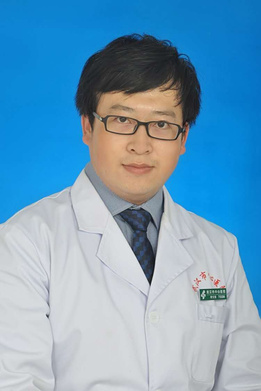
Li Wenliang was a Chinese Manchurian ophthalmologist who warned his colleagues about early COVID-19 infections in Wuhan. On 30 December 2019, Wuhan CDC issued emergency warnings to local hospitals about a number of mysterious "pneumonia" cases discovered in the city in the previous week. On the same day, Li, who worked at the Central Hospital of Wuhan, received an internal diagnostic report of a suspected severe acute respiratory syndrome (SARS) patient from other doctors which he in turn shared with his Wuhan University alumni through a WeChat group. He was dubbed a whistleblower when that shared report later circulated publicly despite his requesting confidentiality from those with whom he shared the information. Rumors of a deadly SARS outbreak subsequently spread on Chinese social media platforms; Wuhan police summoned and admonished him and seven other doctors on 3 January for "making false comments on the Internet about unconfirmed SARS outbreak."
The COVID-19 pandemic in Hubei, part of the global COVID-19 pandemic, was the first identified outbreak of the pandemic, appearing as a cluster of mysterious pneumonia in Wuhan, the provincial capital of Hubei, China. A Wuhan hospital notified the local Center for Disease Control and Prevention (CDC) and health commissions on December 27, 2019. On December 31, Wuhan CDC admitted that there was a cluster of unknown pneumonia cases related to the Huanan Seafood Wholesale Market after the unverified documents appeared on the Internet. The outbreak soon drew nationwide attention, with the National Health Commission (NHC) in Beijing sending medical experts to Wuhan the next day. On January 8, a new coronavirus was identified as the cause of the pneumonia. The sequence of the virus was soon published on an open-access database. Measures taken by China have been controversial. They were praised by the World Health Organization (WHO) for improvements over SARS-CoV-2 responses, but maligned by many in the international community for being slow to publicly disclose key facts or deceptive about the outbreak and for aggressively censoring information related to the outbreak and public discontent from citizens online.
Ai Fen is a Chinese doctor and director of the emergency department of Central Hospital of Wuhan. In December 2019, she was one of the first doctors to encounter pneumonia patients infected with the then-unknown virus, SARS-CoV-2. On 30 December 2019, Ai Fen received a diagnostic report of suspected "Severe Acute Respiratory Syndrome cases". An image of the diagnostic report was shared on WeChat by an ophthalmologist at the hospital, Li Wenliang. The image was then circulated on the internet, leading Ai Fen to be questioned by hospital superiors. She was given the nickname "The Whistle-Giver" (发哨子的人) in an article in the Chinese Renwu magazine which was censored by the Chinese government but was reposted on the Chinese internet using emojis, Morse code and pinyin to circumvent censorship.
Xie Linka is a Chinese physician who gave early warning about the spread of COVID-19 in Wuhan, China. She became known for being a whistleblower, a title given to others in China who had warned the public, such as Liu Wen, and Dr. Li Wenliang, who was infected and later died from the virus.<
Liu Fan was a Chinese deputy chief nurse of Wuchang Hospital in Wuhan, Hubei. She was the first nurse to die from SARS-CoV-2 infection, at the age of 59.
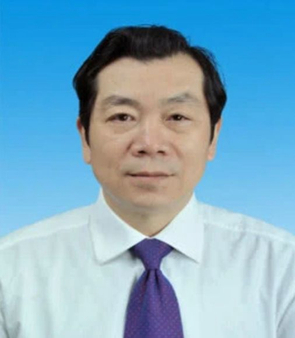
Liang Wudong was a physician at Xinhua Hospital in Wuhan, Hubei, notable for being the first doctor to die from COVID-19 due to a nosocomial infection.
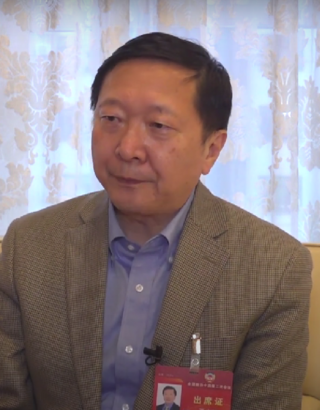
Wang Guangfa is a Chinese physician. He is a respiratory expert at Peking University First Hospital.
Qiu Jun was a Chinese bodybuilder and a bodybuilding champion who claimed numerous prizes in the senior category. He won many national competitions and was ranked 2nd in the international bodybuilding tournament called "Olympic World Night" 2019, which took place in China.
Liu Shouxiang was a Chinese watercolor painter and professor at the Hubei Institute of Fine Arts. His work won many awards and was collected by many art museums. He was also a member of the China Democratic League.
Zhang Jixian is a Chinese pulmonologist. She is known to have discovered SARS‑CoV‑2, and was the director of the Department of Respiratory Medicine of Hubei Provincial Hospital of Integrated Chinese & Western Medicine. She is also a member of the Chinese Communist Party.
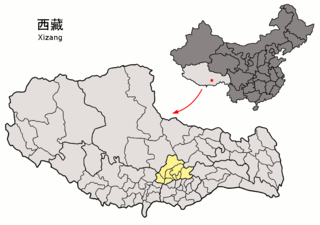
This article documents the situation of the COVID-19 pandemic in the Tibet Autonomous Region.

The COVID-19 pandemic in Beijing is part of the worldwide pandemic of the coronavirus disease 2019 (COVID-19), caused by the severe acute respiratory syndrome coronavirus 2 (SARS-CoV-2). The disease first reached Beijing on 20 January 2020.

This article documents the chronology of the response to the COVID-19 pandemic in January 2020, which originated in Wuhan, China in December 2019. Some developments may become known or fully understood only in retrospect. Reporting on this outbreak began in December 2019.

During the COVID-19 pandemic in mainland China, the government of China under CCP general secretary Xi Jinping's administration pursued a zero-COVID strategy to prevent the domestic spread of COVID-19 until December 7, 2022. Aspects of the response have been controversial, with the zero-COVID approach being praised and the government's lack of transparency, censorship, and spread of misinformation being criticized. The government abandoned its zero-COVID policy on 7 December 2022.
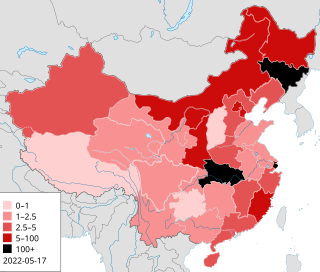
The 2019–2020 COVID-19 outbreak in mainland China was the first COVID-19 outbreak in that country, and the beginning of the COVID-19 pandemic, caused by severe acute respiratory syndrome coronavirus 2 (SARS-CoV-2). China was the first country to experience an outbreak of the disease, the first to impose drastic measures in response, and one of the first countries to bring the outbreak under control.

The COVID-19 pandemic in China is part of the worldwide pandemic of coronavirus disease 2019 (COVID-19) caused by severe acute respiratory syndrome coronavirus 2 (SARS-CoV-2). China was the first country to experience an outbreak of the disease, the first to impose drastic measures in response, and one of the first countries to bring the outbreak under control.










